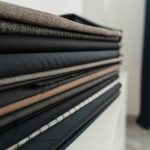Did you know that fire-resistant fabrics can reduce fatalities in fire-related incidents by up to 50%? You might think these fabrics are only used by firefighters, but they're essential in various high-risk industries like military, oil and gas, and even some manufacturing sectors. By integrating advanced materials and chemical treatments, these fabrics don't just resist flames—they actively inhibit combustion. Curious about how these fabrics not only protect but also provide comfort and breathability? You're about to discover the science behind their effectiveness and the innovations that make them indispensable for safety.
Table of Contents
Key Takeaways
- Fire-resistant fabrics employ advanced chemical treatments to inhibit combustion and enhance safety.
- Key industries like firefighting and military rely heavily on fire-resistant fabrics for protection.
- Fire-resistant fabrics include cotton blends, synthetic fibers, and inherently flame-resistant materials like wool.
- Nomex and Kevlar provide superior heat resistance and durability, ideal for high-risk environments.
- Certifications like NFPA and ASTM ensure fire-resistant fabrics meet rigorous safety standards.
The Science Behind Fire-Resistance
Fire-resistant fabrics are engineered to withstand ignition and resist burning. You'll find that the science behind this involves a blend of advanced chemical reactions and material science. When exposed to heat or flames, these fabrics undergo specific chemical reactions that inhibit the combustion process. Fundamentally, the material's structure changes to form a protective barrier, preventing further burning and degradation.
Heat resistance is another important factor. It's not just about stopping flames; these fabrics must also manage high temperatures without compromising their integrity. The fibers in fire-resistant materials are designed to absorb and dissipate heat, lowering the overall temperature and reducing the risk of ignition. This heat management capability is essential, as it provides an extra layer of protection, allowing you to be safer in hazardous environments.
Understanding the precise mechanisms at play, such as the exact chemical reactions and thermal properties, can give you a significant edge in selecting the right fire-resistant fabric for your needs. Mastering this knowledge means you're not just relying on labels but truly comprehending how these fabrics work to protect you from fire-related hazards. This depth of understanding is crucial for ensuring maximum safety and performance.
Types of Fire-Resistant Fabrics
When looking for fire-resistant fabrics, you'll find several options, including cotton blends, synthetic fibers, and natural fibers like wool.
Each type offers different benefits and levels of protection against fire hazards.
Let's explore how these materials can meet your specific needs for safety and comfort.
Cotton Blend Fabrics
Among the various types of fire-resistant fabrics, cotton blend fabrics stand out for their versatility and comfort. When you choose cotton blend fabrics, you're opting for a balanced combination of natural cotton and other materials that enhance fire resistance. This blending of materials offers the best of both worlds: the breathability and softness of cotton, alongside the durability and safety of synthetic fibers.
Cotton safety is paramount, and these blends guarantee that you don't have to compromise on comfort to stay protected. Imagine working long hours in an environment where fire hazards are a concern. You need fabrics that provide not only high-level protection but also maintain comfort throughout the day. Cotton blend fabrics do just that by integrating fire-resistant properties without sacrificing the natural feel of cotton.
These fabrics are treated with special chemicals that enhance their ability to withstand flames, making them ideal for various applications, from industrial settings to everyday wear.
Synthetic Fiber Options
While cotton blend fabrics offer a great balance of comfort and protection, synthetic fibers provide an array of fire-resistant options that excel in durability and specialized applications.
If you're aiming for advanced fire resistance, you can't overlook polyester blends. These fabrics are well-known for their strength and ability to withstand harsh conditions, making them ideal for industrial settings or environments where safety is paramount. You'll find that polyester blends often include additional treatments to enhance their fire-resistant properties, ensuring a robust defense against flames.
Acrylic options also stand out in the domain of fire-resistant fabrics. They combine lightweight characteristics with impressive fire-retardant capabilities. Acrylics are often treated with specific chemicals that allow them to self-extinguish when exposed to fire, providing a critical layer of safety. This makes them particularly useful for applications where both flexibility and fire resistance are essential, such as in home furnishings and protective clothing.
Wool and Natural Fibers
Wool, a natural fiber, offers exceptional fire-resistant properties due to its high nitrogen and water content. When you select wool, you're not just choosing safety; you're also opting for one of the most sustainable options available. Wool's inherent flame resistance means it doesn't ignite easily, and it self-extinguishes when the flame source is removed.
Consider the following benefits:
| Feature | Benefit |
|---|---|
| High Nitrogen Content | Enhances fire resistance |
| Water Absorption | Delays ignition |
| Biodegradability | Environmentally friendly |
Furthermore, wool is a renewable resource, making it a stellar choice for eco-conscious individuals. However, it's essential to verify that the wool you choose adheres to high standards of animal welfare. Look for certifications like the Responsible Wool Standard (RWS) which guarantees that the sheep are treated humanely.
Natural fibers like cotton and linen can also be treated with fire-resistant chemicals, but they don't provide the same inherent protection as wool. By prioritizing wool, you're investing in a fabric that balances safety, sustainability, and ethical considerations. Make an informed decision and elevate your expertise in choosing fire-resistant fabrics.
How Fire-Resistant Fabrics Work
Fire-resistant fabrics incorporate special fibers and chemical treatments to inhibit flame spread. Understanding fire behavior and chemical reactions reveals the importance of these materials for protection.
Different methods achieve fire resistance:
- Inherent Fire Resistance: Some fabrics use naturally flame-resistant fibers that withstand high temperatures without igniting.
- Chemical Treatments: Flame retardant chemicals create a protective barrier, preventing fabric ignition.
- Hybrid Technologies: Combining fire-resistant fibers and treatments optimizes durability and safety.
Flame retardant treatments interrupt combustion reactions, delaying or preventing fire spread. Mastery of these technologies aids in selecting materials for safety-critical environments.
Effective fire resistance relies on meticulous fabric design and engineering, especially in high-risk settings.
Key Industries Using Fire-Resistant Fabrics
You might be surprised at how many industries rely on fire-resistant fabrics for safety.
From protective workwear in industrial settings to essential gear for firefighters and military personnel, these fabrics play an important role.
Let's look at how each sector benefits from these life-saving materials.
Protective Workwear Applications
Industries like firefighting, oil and gas, and electrical utilities heavily rely on fire-resistant fabrics to guarantee their workers' safety. When you're working in these high-risk environments, adhering to strict safety standards is non-negotiable. Fire-resistant fabrics give workers the best protection against potential hazards like flames, heat, and electrical arcs.
To make sure you're both safe and comfortable, these fabrics come with specialized comfort features like breathability and moisture-wicking properties. This means you won't have to sacrifice comfort for safety, even during long shifts in challenging conditions.
In protective workwear, fire-resistant fabrics shine in several key areas:
- Durability: These fabrics are built to withstand harsh conditions, ensuring long-lasting protection.
- Flexibility: Modern fire-resistant fabrics offer enhanced mobility, allowing you to perform your tasks without restriction.
- Maintenance: They're easy to clean and maintain, ensuring they remain effective over time.
Military and Defense Use
Military and defense sectors prioritize flame-retardant fabrics to protect personnel against extreme conditions and potential hazards. When you're operating in high-risk environments, the fabric of your military uniform can be the difference between safety and severe injury.
These specialized fabrics are engineered to withstand high temperatures, thereby providing a crucial layer of protection.
For defense applications, flame-retardant fabrics are indispensable. In combat scenarios, where explosions and fires are real threats, having gear that resists ignition can save lives.
Whether you're dealing with flash fires, electrical arcs, or other heat hazards, these fabrics act as a barrier, reducing the risk of burns and injuries.
Moreover, the technology behind these fabrics has evolved notably. Today's military uniforms aren't only flame-retardant but also lightweight and breathable, ensuring that you remain agile and comfortable.
These advancements mean you don't have to compromise on mobility or performance while staying protected.
In essence, the integration of flame-retardant fabrics in military and defense applications is a sign of the commitment to safeguarding those who serve. By prioritizing this essential gear, you're ensuring that personnel are equipped to handle the most challenging conditions with confidence and security.
Firefighting Gear Essentials
Fire-resistant fabrics are equally important in firefighting gear, where the stakes are just as high as in military operations. When you're outfitting firefighter uniforms, it's essential to prioritize materials that can withstand extreme heat and flames. This isn't just about protection; it's about enabling firefighters to perform in the most hazardous conditions without compromising their safety or efficiency.
Consider these key elements in firefighting gear:
- Thermal Resistance: Guarantees that the fabric can endure high temperatures without degrading.
- Durability: Allows the uniform to withstand physical wear and tear encountered during firefighting.
- Comfort and Mobility: Enhances the ability of firefighters to move freely and perform their duties effectively.
Industrial safety standards are strict, and for good reason. Firefighters face unpredictable and dangerous environments, requiring gear designed for optimal protection. The right fire-resistant fabrics offer the perfect balance of thermal resistance and durability, making them indispensable for firefighter uniforms.
These fabrics are engineered to resist ignition and prevent burns, providing an essential layer of defense.
Benefits of Fire-Resistant Fabrics
Choosing fire-resistant fabrics can greatly enhance safety and protection in various environments. When you incorporate these materials into your home decor, you're not just adding aesthetic value but also increasing your household's safety.
These fabrics are designed to withstand high temperatures, reducing the risk of fire-related accidents. Imagine the peace of mind you'll have knowing your curtains, upholstery, and rugs offer an extra layer of protection against potential fire hazards.
For outdoor clothing, fire-resistant fabrics are indispensable. Whether you're an avid camper, hiker, or someone who works in high-risk environments, these materials can protect you from unexpected flare-ups.
Fire-resistant outdoor clothing is crafted to provide durability and comfort while ensuring that you're shielded from fire-related dangers. This safety feature is critical, especially when you're in remote areas where immediate help mightn't be accessible.
Innovations in Fire-Resistant Textiles
Recent advancements in fire-resistant textiles are revolutionizing how we think about safety and comfort. You're no longer limited to bulky, uncomfortable gear. Modern innovations seamlessly blend functionality with style, catering to both your safety needs and aesthetic desires.
One of the most exciting areas of development is sustainable innovations. Cutting-edge research is leading to the creation of eco-friendly fire-resistant fabrics. These fabrics aren't only effective at resisting flames but are also made from renewable resources, reducing environmental impact.
Fashion trends are also evolving to incorporate fire-resistant materials. Designers are now creating chic, everyday wear that offers fire protection without compromising on style. Imagine wearing a sleek jacket or a trendy pair of pants that also safeguard you from potential fire hazards.
- Breathable Fabrics: Advanced textiles now allow for better airflow, ensuring comfort during prolonged wear.
- Enhanced Durability: New treatments and fibers make these fabrics more durable, extending their lifespan and reducing the need for frequent replacements.
- Versatile Applications: From casual wear to professional uniforms, fire-resistant fabrics are now available in various forms to suit different needs.
These innovations mean you don't have to choose between safety and style anymore.
Common Myths About Fire-Resistant Fabrics
While innovations in fire-resistant textiles are impressive, it's important to address some common myths that could mislead you about their capabilities and uses.
One common misconception is that fire-resistant fabrics are completely fireproof. In reality, these fabrics are designed to resist ignition and prevent the spread of flames, but they can still be damaged by fire under extreme conditions.
Another myth is that fire-resistant fabrics are only relevant for industrial applications. In fact, these materials have significant consumer applications, particularly in home use. Bedding, curtains, and upholstery made from fire-resistant fabrics can add an extra layer of safety to your home environment.
You might also believe that all fire-resistant fabrics meet the same safety standards. However, different fabrics can comply with various regulations depending on their intended use. Always check the specific safety standards to guarantee the fabric meets the required criteria for your application.
Lastly, there's a notion that fire-resistant fabrics are uncomfortable or unattractive. Modern advancements have made it possible to produce materials that are both aesthetically pleasing and comfortable, making them suitable for everyday use without compromising on safety.
Care and Maintenance Tips
Proper care and maintenance will prolong the life and effectiveness of your fire-resistant fabrics. Adhering to proper washing instructions is essential. Use mild detergents and avoid bleach or fabric softeners, as they can degrade the fabric's protective properties. Always wash in cool or warm water and set your machine to a gentle cycle.
Storage tips are equally important. Guarantee your fire-resistant garments are stored in a cool, dry place away from direct sunlight. Avoid hanging them in damp areas as moisture can compromise their integrity.
Regular inspections should be part of your routine. Establish an inspection checklist to identify any signs of wear and tear, such as:
- Rips or tears: Address these immediately to maintain protection.
- Fading or discoloration: This could indicate a loss of fire-resistant properties.
- Seam integrity: Ensure all seams are intact and secure.
When it comes to repair guidance, always use thread and patches that are also fire-resistant. Avoid DIY fixes with non-compliant materials as they can compromise safety. If damage is beyond simple repairs, it's best to replace the garment entirely.
Following these care and maintenance tips guarantees your fire-resistant fabrics remain reliable and safe.
Choosing the Right Fire-Resistant Fabric
Selecting the right fire-resistant fabric requires understanding your specific needs and the different materials available. You've got to match the fabric's properties with the environment where it'll be used. Start by evaluating the level of fire resistance you need.
For instance, Nomex and Kevlar are excellent for high-risk settings due to their superior heat resistance and durability.
Fabric selection depends heavily on safety standards. Make sure the materials you consider meet industry-specific certifications. Look for labels like NFPA (National Fire Protection Association) or ASTM (American Society for Testing and Materials). These standards guarantee that the fabric has undergone rigorous testing and meets the criteria for fire resistance.
Next, think about comfort and functionality. If the fabric is for everyday wear, you'll want something breathable and flexible, like treated cotton blends. On the other hand, for extreme conditions, heavier fabrics like PBI or CarbonX might be necessary despite their reduced comfort.
Frequently Asked Questions
Are Fire-Resistant Fabrics Environmentally Friendly?
You might wonder if fire-resistant fabrics are environmentally friendly. Sustainability in their production can vary. Some methods use eco-friendly processes, while others involve chemical treatments that may not be as green.
Do Fire-Resistant Fabrics Lose Their Properties Over Time?
Did you know 60% of fire-resistant fabrics lose some effectiveness after 50 washes? Durability concerns arise due to maintenance requirements and aging effects. Proper care can mitigate these issues, ensuring long-term protection and reliability.
Can Fire-Resistant Fabrics Be Recycled?
Yes, you can recycle fire-resistant fabrics. Explore recycling options and sustainability initiatives to guarantee you're disposing of them responsibly. Embrace these methods to contribute to environmental conservation while maintaining your dedication to safety and mastery.
Are Fire-Resistant Fabrics Breathable and Comfortable to Wear?
Imagine a second skin that shields you from flames. With advancements in technology, fire-resistant fabrics now offer breathability and comfort. You'll find they're not just protective armor but also wearable, everyday comfort and ease.
How Do Fire-Resistant Fabrics Compare in Cost to Regular Fabrics?
When you compare the cost, fire-resistant fabrics are typically more expensive than regular fabrics. However, a durability analysis reveals they last longer, making them a better long-term investment despite the initial higher cost.
- Everything You Should Know About Nonwoven Wallpaper - July 11, 2025
- Woven vs. Nonwoven Bags: Which Is the Greener Choice? - July 11, 2025
- Nonwoven Fabric Production Methods: A Visual Guide - July 11, 2025







